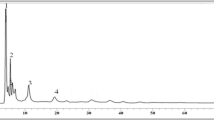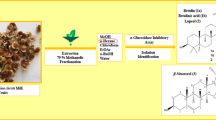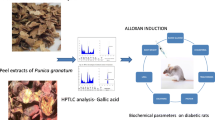Abstract
Diabetes mellitus is a metabolic disorder of carbohydrate metabolism. The management of Diabetes mellitus with phytochemicals is hallmark of this research. Citrus species are known for their health benefits and are used as traditional food in South East Asia. The total phenolic content of peels was analyzed using different solvents, while Gallic acid was used as standard. Both ethanolic, aqueous extracts of Citrus reticulata peel showed good inhibitory activity against amylase (90.67%, 15.33%) and moderate against glucosidase (70.8%, 14.8%), respectively. Sixteen rats were randomly divided into four groups (G1, G2, G3, and G4); G1 is a negative control (water), G4 is a positive control (Acarbose), while other two are experimental groups like G2 (fed with 100 mL and 20 mg/mL in hypoglycemic and hyperglycemic trials) and G3 fed with 200 mL and 40 mg/mL in hypoglycemic and hyperglycemic trials. A significant effect of treatments and value of time was found in hyperglycemic rats. Ethanolic extract showed a significant reduction in blood glucose levels in hypoglycemic (overnight fasting) rats which was comparable to the positive control. These results suggest that C. reticulata peels can contribute as a useful food ingredient as a potential antihyperglycemic agent in managing type 2 diabetes mellitus. In future, C. reticulata peel will be a good candidate for pharmaceutical industry.




Similar content being viewed by others
References
Aruoma OI, Landes B, Ramful-Baboolall D, Bourdon E, Neergheen-Bhujun V, Wagner K-H, Bahorun T (2012) Functional benefits of citrus fruits in the management of diabetes. Prev Med 54:S12–S16
Asencio AD, Serrano M, García-Martínez S, Pretel MT (2018) Organic acids, sugars, antioxidant activity, sensorial, and other fruit characteristics of nine traditional Spanish citrus fruits. Eur Food Res Tech 244(8):1497–1508
Bhagyawant S et al (2019) Chickpea (Cicer arietinum L.) lectin exhibit inhibition of ACE-I, α-amylase and α-glucosidase activity. Protein Pept Lett 26(7):494–501. https://doi.org/10.2174/0929866526666190327130037
Borg MJ, Jones KL, Sun Z, Horowitz M, Rayner CK, Wu T (2019) Metformin attenuates the postprandial fall in blood pressure in type 2 diabetes. Diabetes Obes Metab 21(5):1251–1254. https://doi.org/10.1111/dom.13632
Bouabid K, Lamchouri F, Toufik H, Sayah K, Cherrah Y, Faouzi ME (2018) Phytochemical screening and in vitro evaluation of alpha amylase, alpha glucosidase and beta galactosidase inhibition by aqueous and organic Atractylis gummifera L. extracts. Plant Sci Today 5(3):103–112. https://doi.org/10.14719/pst.2018.5.3.393
Camberos EP, Díaz EL, Fernandez JMF, Owolabi MS, Allen K, Socorro Villanueva-Rodríguez SV (2014) Evaluation of the inhibition of carbohydrate hydrolyzing enzymes, the antioxidant activity, and the polyphenolic content of Citrus limetta peel extract. Sci World J. https://doi.org/10.1155/2014/121760
Dagenais GR et al (2016) Variations in diabetes prevalence in low, middle, and high-income countries: results from the prospective urban and rural epidemiological study. Diabetes Care 39(5):780–787. https://doi.org/10.2337/dc15-2338 (PMID: 26965719)
Demiray S, Pintado ME, Castro PML (2009) Evaluation of phenolic profiles and antioxidant activities of Turkish medicinal plants: Tilia argentea, Crataegi folium leaves and Polygonum bistorta roots. World Acad Sci, Eng Tech 54:312–317
Du Vigneaud V, Karr WG (1925) Carbohydrate utilization. J Biol Chem 66:281
Fathima MH, Thangavelu L, Roy A (2018) Anti-diabetic activity of cassia fistula (alpha amylase–inhibitory effect). J Adv Pharm Edu Res 8(2):12–15
Habib MR, Kabir MS, Mominur M, Chowdhury M, Rahman A (2017) In vitro α-amylase inhibitory potential and in vivo hypoglycemic effect of organic extracts of phrynium imbricatum roxb leaves. Med One https://doi.org/10.20900/mo.20170026
Harrison DE, Strong R, Alavez S, Astle CM, DiGiovanni J, Fernandez E, Flurkey K, Garratt M, Gelfond JA, Javors MA, Levi M (2019) Acarbose improves health and lifespan in aging HET3 mice. Aging Cell 18(2):e12898. https://doi.org/10.1111/acel.12898
Ibrahim MA, Habila JD, Koorbanally NA, Islam MS (2017) α-Glucosidase and α-amylase inhibitory compounds from three African medicinal plants: an enzyme inhibition kinetics approach. Nat Prod Commun. https://doi.org/10.1177/1934578X1701200731
Kalita D, Holm DG, LaBarbera DV, Petrash JM, Jayanty SS (2018) Inhibition of α-glucosidase, amylase, and aldose reductase by potato polyphenolic compounds. PLoS ONE 13(1):e0191025. https://doi.org/10.1371/journal.pone.0191025
Karakaya S, Gözcü S, Güvenalp Z, Özbek H, Yuca H, Dursunoğlu B et al (2018) The α-amylase and α-glucosidase inhibitory activities of the dichloromethane extracts and constituents of Ferulago bracteata roots. Pharm Biol 56(1):18–24. https://doi.org/10.1080/13880209.2017.1414857
Kazeem MI, Adamson JO, Ogunwande IA (2013) Modes of inhibition of α-amylase and α-glucosidase by aqueous extract of Morinda lucida benth leaf. Przyborski JM, editor. Biomed Res Int. https://doi.org/10.1155/2013/527570
Kumar KP, Reddy VR, Prakash MG, Kumar KP (2018) In vitro estimation of total phenolics and DPPH radical scavenging activity of Withania somnifera extract. Pharma Innov J 7(3):588–590
McDougall GJ, Shpiro F, Dobson P, Smith P, Blake A, Stewart D (2005) Different polyphenolic components of soft fruits inhibit α-amylase and α-glycosidase. J Agric Food Chem 53(7):2760–2766
Menichini F, Loizzo MR, Bonesi M, Conforti F, De Luca D, Statti GA et al (2011) Phytochemical profile, antioxidant, anti-inflammatory and hypoglycemic potential of hydroalcoholic extracts from Citrus medica L. cv Diamante flowers, leaves and fruits at two maturity stages. Food Chem Toxicol 49(7):1549–1555. https://doi.org/10.1016/j.fct.2011.03.048
Mettupalayam Kaliyannan Sundaramoorthy P, Kilavan Packiam K (2020) In vitro enzyme inhibitory and cytotoxic studies with Evolvulus alsinoides (Linn) Linn leaf extract: a plant from Ayurveda recognized as Dasapushpam for the management of Alzheimer’s disease and diabetes mellitus. BMC Complement Med Ther 20(1):129. https://doi.org/10.1186/s12906-020-02922-7
Misra A, Sattar N, Tandon N et al (2018) Clinical management of type 2 diabetes in South Asia. Lancet Diabetes Endocrinol 6(12):979–991. https://doi.org/10.1016/S2213-8587(18)30199-2
Mourya P (2018) In-vitro studies on inhibition of alpha amylase and alpha glucosidase by plant extracts of Alternanthera Pungens kunth. J Drug Delivery Therap 8(6):64–68
Mumtaz MW, Al-Zuaidy MH, Abdul Hamid A, Danish M, Akhtar MT, Mukhtar H (2018) Metabolite profiling and inhibitory properties of leaf extracts of Ficus benjamina towards α-glucosidase and α-amylase. Int J Food Prop 21(1):1560–1574. https://doi.org/10.1080/10942912.2018.1499112
Munir MT, Kheirkhah H, Baroutian S, Quek SY, Young BR (2018) Subcritical water extraction of bioactive compounds from waste onion skin. J Cleaner Prod 183:487–494. https://doi.org/10.1016/j.jclepro.2018.02.166
Oboh G, Ademosun AO (2011) Phenolic Extracts from Grapefruit Peels (Citrus Paradisi) inhibit key enzymes linked with type 2 diabetes and hypertension. J Food Biochem 35(6):1703–1709
Padilla-Camberos E, Lazcano-Díaz E, Flores-Fernandez JM, Owolabi MS, Allen K, Villanueva-Rodríguez S (2014) Evaluation of the inhibition of carbohydrate hydrolyzing enzymes, the antioxidant activity, and the polyphenolic content of Citrus limetta peel extract. Sci World J. https://doi.org/10.1155/2014/121760
Poovitha S, Parani M (2016) In vitro and in vivo α-amylase and α-glucosidase inhibiting activities of the protein extracts from two varieties of bitter gourd (Momordica charantia L.). BMC Complement Altern Med 16(1):185. https://doi.org/10.1186/s12906-016-1085-1
Proteggente AR, Saija A, De Pasquale A, Rice-Evans CA (2003) The compositional characterisation and antioxidant activity of fresh juices from sicilian sweet orange (Citrus sinensis L. Osbeck) varieties. Free Radical Res 37:681–687
Pulido R, Bravo L, Saura-Calixto F (2000) Antioxidant activity of dietary polyphenols as determined by a modified ferric reducing/antioxidant power assay. J Agric Food Chem 48(8):3396–3402
Rahman NF, Shamsudin R, Ismail A, Shah NN, Varith J (2018) Effects of drying methods on total phenolic contents and antioxidant capacity of the pomelo (Citrus grandis (L.) Osbeck) peels. Innov Food Sci Emerg Technol 50:217–225. https://doi.org/10.1016/j.ifset.2018.01.009
Sales M, Ballesteros E (2012) Seasonal dynamics and annual production of cystoseira crinita (Fucales: Ochrophyta)-dominated assemblages from the northwestern Mediterranean| Dinámica estacional y producción anual de las comunidades dominadas por cystoseira crinita (Fucales: Ochrophyta) del mediterráneo noroccidental
Sekar V, Chakraborty S, Mani S, Sali VK, Vasanthi HR (2019) Mangiferin from Mangifera indica fruits reduces post-prandial glucose level by inhibiting α-glucosidase and α-amylase activity. South Afr J Bot 120:129–133. https://doi.org/10.1016/j.sajb.2018.02.001
Sir Elkhatim KA, Elagib RA, Hassan AB (2018) Content of phenolic compounds and vitamin C and antioxidant activity in wasted parts of Sudanese citrus fruits. Food Sci Nutr 6(5):1214–1219. https://doi.org/10.1002/fsn3.660
Sun Y, Shen Y, Liu D, Ye X (2015) Effects of drying methods on phytochemical compounds and antioxidant activity of physiologically dropped un-matured citrus fruits. LWT Food Sci Technol 60(2):1269–1275. https://doi.org/10.1016/j.lwt.2014.09.001
Tadera K, Minami Y, Takamatsu K, Matsuok T (2006) Inhibition of α-glucosidase and α-amylase by flavonoids. J Nutr Sci Vitaminol 52(2):149–153
Uddin N, Hasan MR, Hossain MM, Sarker A, Nazmul Hasan AHM, Mahmudul Islam AFM et al (2014) In vitro α-amylase inhibitory activity and in vivo hypoglycemic effect of methanol extract of Citrus macroptera Montr fruit. Asian Pac J Trop Biomed 4(6):473–479. https://doi.org/10.12980/APJTB.4.2014C1173
Wild S, Roglic G, Green A, Sicree R, King H (2004) Global prevalence of diabetes: estimates for the year 2000 and projections for 2030. Diabetes Care 27:1047–1053
Wilkerson HL, Hyman H, Kaufman M, McCuistion AC, Francis JOS (1960) Diagnostic evaluation of oral glucose tolerance tests in nondiabetic subjects after various levels of carbohydrate intake. N Engl J Med 262:1047–1053
Yang CY, Yen YY, Hung KC, Hsu SW, Lan SJ, Lin HC (2019) Inhibitory effects of Pu-erh tea on alpha glucosidase and alpha amylase: a systemic review. Nutrition Diabetes 9(1):23. https://doi.org/10.1038/s41387-019-0092-y
Acknowledgements
We are thankful to Director IBBT, Prof. Dr. Wasim Shahzad for providing great support to conduct this research project.
Author information
Authors and Affiliations
Corresponding author
Ethics declarations
Conflict of interest
Authors declare that manuscript has not any conflict of interest.
Ethical approval
The research was conducted after approval from independent ethical committee UVAS vide letter no. 118/BeST center 18.
Rights and permissions
About this article
Cite this article
Ghauri, S., Raza, S.Q., Imran, M. et al. Assessment of α-amylase and α-glucosidase inhibitory potential of Citrus reticulata peel extracts in hyperglycemic/hypoglycemic rats. 3 Biotech 11, 167 (2021). https://doi.org/10.1007/s13205-021-02717-8
Received:
Accepted:
Published:
DOI: https://doi.org/10.1007/s13205-021-02717-8




